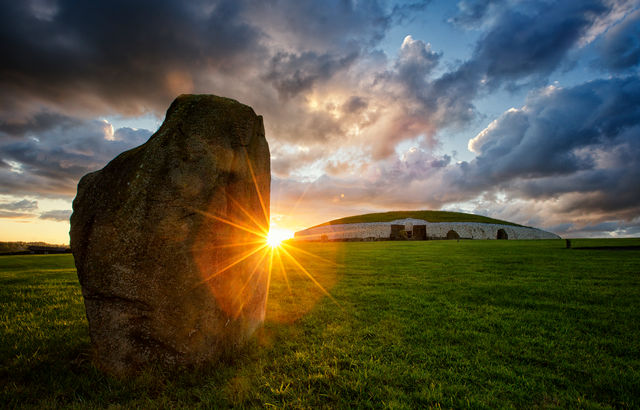Newgrange and the Boyne Valley Tombs
Newgrange – 'Bru na Boinne'
Perched upon a hill in the lush green Boyne valley where the sweeping River Boyne meaders by, is Newgrange. It is one of the most outstanding examples of prehistoric architecture in the world.
Before the invention of the wheel materials had to be transported by boat or by hand over relatively long distances. Its size and sophistication singles it out as the greatest structure of that time,13 metres high and 85 meteres wide with a shining quartz façade,it would have amazed all that saw it. An epic feat of engineering.
For 5,000 years it lay undiscovered until a farm labourer in the 17th century who was removing stones from the mound saw a passage appear before him. It wasn’t until 300 years later in 1967 that the Winter Solstice lighting effect was witnessed, for 17 mins on the shortest day of the year the suns rays illuminate the length of the tombs passage. Various interpretations are given, that it was to honour the sun, to celebrate the fact that from that day on the days would be getting longer or possibly a celebration of the post harvest season.
The passage itself is said to resemble a womb indeed 'bru' is an old gaelic word for womb, 'bru na boinne' – womb of the cow goddess, (it could also mean ‘mansion of the boyne, boyne was the wife of the chief god). Could the sun entering the tomb be a symbol of fertility perhaps?
Lining up the monument to only let light in on one day of the year was a great feat, knowledge of the suns movements and astronomy must have been well known by the ancient community of builders. The stars and sun would have been seen in a whole other light than today where their importance isn’t as directly appreciated.
A startling fact is that there is more ancient carved art in Bru na Boinne than in the rest of Western Europe combined! The famous Irish symbol the triple spiral is only found in Newgrange .
The sheer effort involved in the construction of this giant tumulus would have taken generations, quartz was transported from 60km away, giant boulders from 30km away along the river system. The corbelled roof involved huge stones to be put delicately in place upon one another to create a dome like structure.
Ceremony and cremations would have gone hand in hand, with human remains found in Newgrange and the other Boyne valley tombs including Knowth and Dowth .The area is almost surrounded by water, the siting of which which apart from food and transport could have been for defence or to create a seperate sense of place to honour the dead.
Whatever its purpose Newgrange produces as much questions as answers, today the area around the monuments is still farmed as it was in prehistoric times. The date of the monument cannot be accurately stated roughly somewhere between 3.200 and 2,500 B.C.! It is a special place of mystery and wonderment that is an absolute must see if visiting Ireland, time allowing that is.
Newgrange and the Boyne valley are close to Dublin and near the famous 'Battle of the Boyne' site. Its an ideal stop if en route to Belfast, if touring around Dublin or as a detour if on a trip or a Private Tour to the beautiful West of Ireland.
For advice and Itinerary planning of your Luxury Tour of Ireland - Contact Us
Share


